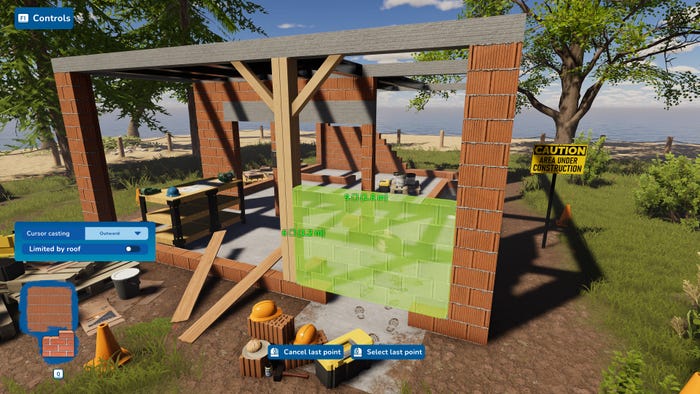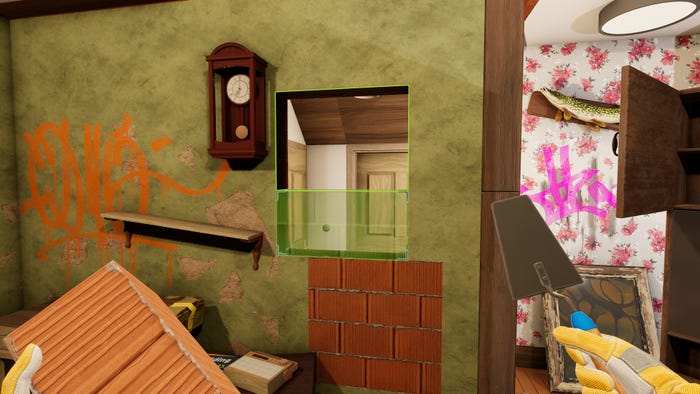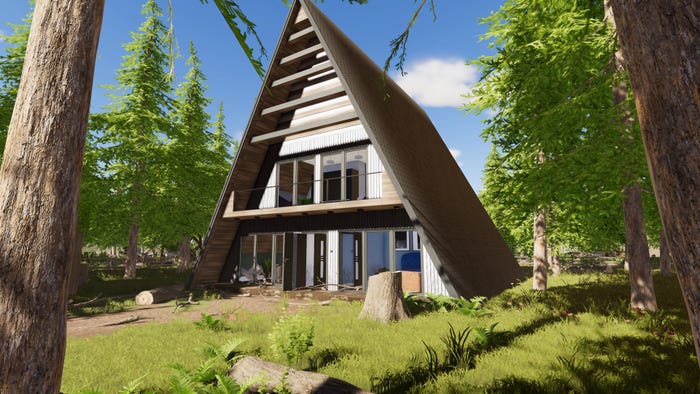
House Flipper 2 sees players sprucing up old homes for fun and profit yet again, but with twists on the original that allow budding home builders to really go wild with their creations.
Game Developer sat down with the team at Frozen District to talk about how its new sandbox mode came about through clever use of the game’s level design tools, the importance sound can have when creating satisfying in-game actions (and avoiding making annoying ones), and how they wove a narrative through a game about painting walls and tearing up floors.
Game Developer: House Flipper 2 once again allows players to turn dingy old homes into gorgeous living spaces. What drew you to create a sequel to the original House Flipper? How did you want to build upon that experience?
Jakub Pacura, senior business developer: We decided to make House Flipper 2 (HF2) for many different reasons, but the main one was that the original House Flipper (HF1) was limiting us from introducing new features to the game.
Back in 2016, our team was pretty inexperienced, and we had a big technical debt because of it. So, as soon as we released HF1 in 2018, our senior developer, Rafał Kańka, started preparing architecture for HF2, which would be more flexible and easier to build upon. Thanks to this, we could add new features we always wanted to have but never could in HF1.
This game introduces a sandbox mode to let players build their own homes from scratch. What thoughts and ideas went into designing this mode? How was it different to design this mode than the gameplay for the regular renovations?
Pacura: A big community of players has been built around HF1. We heard those players’ feedback, ideas, and complaints. Something they always wanted to have was the option to build houses from scratch, hence the sandbox mode. It is a separate mode because not everyone likes it, and we don’t want to impose it on anyone.
The sandbox mode is designed for a bit more “hardcore” players than the story mode because it needs many more options to allow players all customization options. A fun fact is that the sandbox mode was first built for our level designers who were creating houses and missions in the game. It took us a lot of iteration to make it look the way it looks now, but thanks to our level designers’ feedback, we kept improving it.
Can you tell us a bit more about how player feedback affected the design of House Flipper 2? What changes did you make to the game based on what players liked or disliked about the original House Flipper?
Michał Lewandowski, PR specialist: Our community is a constant source of inspiration for us! After all, we make the game for them (although a little bit for ourselves). Over the years, during the development of HF1, we received hundreds of ideas and inspirations from our community that found their way into the game. Even some DLC was inspired by them.
In House Flipper 2, we carefully analyzed what was missing in the previous one and what got in the way. One of the things that players had eagerly awaited for years was Sandbox mode: the ability to build houses from scratch and even create custom jobs. In House Flipper 2, this mode is one of the game’s main mechanics; we are very proud of it!
.jpg?width=700&auto=webp&quality=80&disable=upscale)
Images via Frozen District.
What challenges came from creating the more complex sandbox mode? How did you work to make it straightforward and approachable for players while still giving them the depth they needed to make their own creative homes?
Jakub Bujas, game producer: Sandbox Mode was the biggest development challenge for our company. It is a complex and powerful tool that is basically a level creator. Giving players the possibility to make their own creations using the same tools as our level designers use was the main goal during the production process.
In terms of UX, it was a really tough task because players don’t possess the knowledge and documentation that our employees have. We had to patiently design each of the mechanics to make it as intuitive as possible. That’s why, at some point, we decided to run events called “Domkatons,” which were basically days when the whole company was focused on using Sandbox Mode for recreating our favorite spaces. Those allowed us to check if Sandbox Mode is straightforward for any type of player.
Can you tell us about some personal favorite homes you’ve seen made by the community? Some particularly intriguing creations that have impressed you?
Pacura: In HF1, every now and then, we were seeing designs we couldn’t believe were done in our game… People are wildly creative! In HF2, with all the new customization options, we can’t even imagine what houses people will create going forward. And that’s super exciting for us!
1.5 months after the release, we already have more than 1000 houses on mod.io. We even have a special discord channel for the best houses so we can appreciate the creativity the players put into them.
Here are some of my favorite ones: Gingerbread House,
Pink Paradise, Castle, and Enchanted Abode.
What new designs and activities did you bring into the renovation portion of the game? What research did you do into home renovation and design in order to bring some fun new elements to this sequel?
Bujas: Based on the feedback from our community and experience gathered from the development of HF1, we came up with some upgrades to “classic” mechanics and introduced new ones. We especially focused on quality-of-life improvements for the Flipper Tool mainly used in the first game for selling items.
In the sequel, we also provide possibilities for cloning items, copy-pasting styles, and redesigning existing ones, which are crucial for complex renovations. From new activities, the most significant are creating connections between light switches and light sources, as well as unpacking boxes.
In terms of research, we spent a lot of time watching HGTV, creating documentation of existing furniture styles and grouping them into in-game companies, exploring colors and how to combine them to get the right item presets, and analyzing video materials about tearing down walls, assembling items, and other activities performed by professionals.

Images via Frozen District.
Many of the building and renovating actions are satisfying to watch. How do you make it visually pleasing to do hard labor like bricklaying, demolition, or building? Likewise, what thoughts went into the sounds behind these actions to make them feel good to carry out?
Bujas: Our main goal was to create a cozy chill-out game that combined simulation and sandbox vibes. Prior to achieving this, we had to remember that some actions, like knocking down walls, can look satisfying, but at the same time, they can be stressful. The key to success is to find the right balance between actual gameplay and visual effects. Some actions carry the risk of becoming boring if they take too long to complete. To solve this issue, we put optional minigames to mechanics to diversify gameplay. For instance, in building walls, you can click on the active row of bricks under construction, and that speeds up the action.
A well-planned sound design in simulation games is really important. When you do the same task many times (especially in a row), it is essential to have as few annoying sound effects as possible. The vacuuming is one of those actions that needs to be implemented in the way that it almost mimics natural sounds, but at the same time, it does not drill your head after a few minutes of gameplay. People don’t demand any extraordinary sound effects in these kinds of games, however, a lack of sound effects or a drift from what’s considered “natural” sounds breaks the immersion.
House Flipper 2 encourages a great deal of creativity in its players. How does it feel to create this kind of canvas that encourages players to express themselves and to see that you’ve given players a tool to create something wonderful?
Bujas: It is a wonderful feeling when you can see that your game offers players so many possibilities for unleashing their creativity. Moreover, it is priceless when someone invents new ways of using your tools. In typical sandbox games, developers prepare a more linear gameplay experience that shows players only a single default path forward. Discovering how players then use your tools in an innovative way is so gratifying. It’s one of the reasons why we create computer games!

Images via Frozen District.
Progression and skills make it feel like your skills are growing as you fix up homes and build new ones. What thoughts went into designing the skills players could improve in the game? How did you design these to make players feel like they’re getting better at home building?
Lewandowski: In HF2, akin to HF1, skills are organized into various themes. Players accumulate points in a particular category by executing actions that are closely related to the skill’s theme. For instance, in the ‘Flipper Tool’ category, players earn points by frequently scanning or selling furniture. The more they engage in these activities, the higher their score in this category, unlocking new skill levels. We wanted a flexible perks system where players could switch on and off each individual perk at any time and choose another without consequences so that players could experiment and choose the skill tree they felt gave them the most and was more enjoyable. The skills are graded, which means that they have several stages of development; thus, to unlock the next more powerful stage, it is already required to have a point in its earlier version.
You have also designed a story mode within the game. What thoughts go into creating a story mode for a house-building & renovation game? How did you weave a story into House Flipper 2 without getting in the way of the gameplay? How did you work it into the game in subtle ways?
Lewandowski: To weave various stories into the game, we used the enviro-storytelling technique, which conveys stories through objects, their layout, photos, and sometimes by adding some text to the objects. A player who is curious about the story has a chance to connect these various scattered elements in the game. This makes it so that a player not interested in lore can skip over these things. Of course, we avoid “walls of text” because they greatly discourage players from reading, so NPC emails are not long.
What appealed to you about adding a story mode to the game? What thoughts went into creating modes that would satisfy many different types of players to make House Flipper 2 more engaging for them?
Lewandowski : You know, all people think through stories and constantly tell themselves different narratives. That’s why we added such a mode so the player would be more involved in the game and experience as good a feeling of immersion as possible. Telling a story about renovating houses in a small town, where various secrets and references are awaiting to be discovered, is natural and very attractive to our players. Besides, we have talked to them a lot about it, and they welcome this way of exploring the game’s lore.






